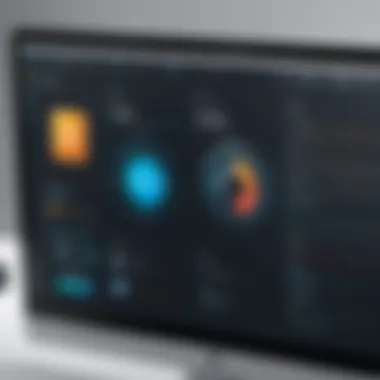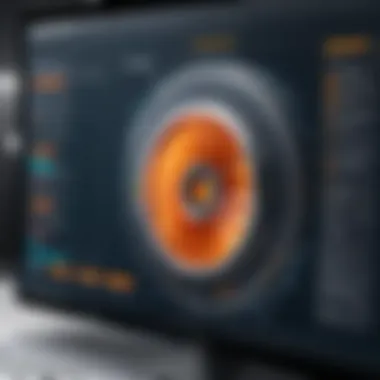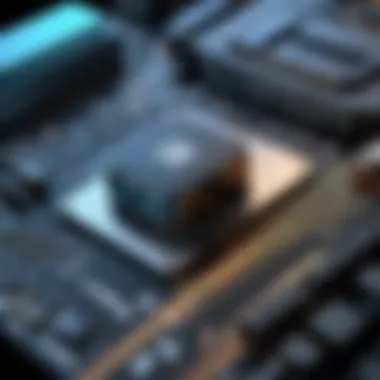Punch Design Software: A Comprehensive Overview


Intro
In today's fast-paced technological landscape, software tools have become pivotal in optimizing design processes across various fields. Punch design software stands out due to its specialized functionalities that cater to both individual designers and larger organizations. This comprehensive overview aims to elucidate the key elements of punch design software, focusing on its features, applications, and overall benefits.
Brief Description
Punch design software is a tailored solution that streamlines the process of creating and managing punch designs. These applications are integral in industries such as packaging and manufacturing, where precision and efficiency are paramount. By harnessing technology, these tools help designers prototype and adjust their designs with remarkable speed and accuracy.
Overview of the software
Punch design software allows users to generate detailed models of punch dies or tooling components. It serves as a vital asset for those engaged in tooling design and production. Not only does it enhance creativity, but it also minimizes lead times by transforming ideas into functional designs quickly.
Key features and functionalities
Some notable features include:
- 3D Modeling: Create intricate designs in a three-dimensional space, offering a better visualization of the final product.
- Simulation Tools: Analyze designs under various conditions to predict performance and identify potential issues.
- Library of Components: Access pre-existing designs and components that can be modified and reused, saving time in the design phase.
- Integration Capabilities: Seamlessly connect with other software tools, enhancing workflow across different stages of the design process.
"The adoption of punch design software can significantly reduce production errors and improve time management across design stages."
System Requirements
To ensure optimal performance of punch design software, understanding the system requirements is crucial.
Hardware requirements
Users need to consider the following:
- Processor: A multi-core processor is recommended to handle complex computations.
- Memory: A minimum of 8GB RAM is advisable for smooth functionality, though 16GB or more is preferred for larger projects.
- Storage: Solid State Drives (SSD) will enhance overall performance, as they load applications and files faster than traditional drives.
- Graphics Card: A dedicated graphics card facilitates 3D modeling and rendering processes effectively.
Software compatibility
Punch design software usually operates on various operating systems, primarily Windows. It is essential to verify compatibility with specific versions of Windows before installation. Additionally, regular updates and patches from the software provider should be installed to ensure security and performance are maintained.
This overview sets the stage for a deeper exploration into punch design software's capabilities and advantages, catering to a wide range of user expertise from novices to seasoned professionals.
Preamble to Punch Design Software
Punch design software is an essential tool for professionals and businesses focusing on designing and manufacturing products that involve the punching process. This software streamlines design functions, enabling users to create complex shapes and patterns with precision. Moreover, it enhances overall efficiency and productivity in design workflows.
With increasing competition in various industries, the necessity for high-quality and swift production has become paramount. Punch design software serves not just as a tool but as a strategic asset that can significantly impact the bottom line and deliver superior results.
Definition and Purpose
Punch design software refers to programs specifically developed to assist in the creation of designs related to punching operations. The primary purpose of this software is to facilitate the design process by providing a platform for drafting, modeling, and simulating punch designs. It caters to industries such as metalworking, textiles, and packaging, where precision and accuracy are crucial.
Through user-friendly interfaces, punch design software simplifies complex technical tasks. This helps users quickly conceptualize and execute designs while minimizing the risks of errors in manufacturing. The ability to visualize designs before production allows for adjustments, ensuring that the final product adheres to quality standards and specifications.
Historical Context and Development
The evolution of punch design software is closely tied to advancements in computer-aided design (CAD) technologies. Initially, design processes were manual and labor-intensive, often leading to errors and inconsistencies. With the rise of digital technology in the late 20th century, software solutions began to emerge, providing more efficient methods for designing.
As industries began to recognize the benefits of automation, developers responded by enhancing punch design tools. These improvements included advanced modeling features, integration capabilities with other software, and the incorporation of real-time simulation for better design validation.
Today, the software has transformed into sophisticated solutions that empower a broad range of users, from seasoned professionals to newcomers in the design field.
Key Features of Punch Design Software
Understanding the key features of punch design software is essential for professionals seeking to optimize their design processes. This section explores the core functionalities that define punch design software. These characteristics not only enhance user efficiency but also provide substantial benefits for businesses and individual users alike. An awareness of these features leads to better usage of the software, fostering productivity and creativity.


User Interface and User Experience
The user interface (UI) is the first point of interaction between the user and the software. A well-designed interface facilitates ease of use, which is crucial for both novices and experienced professionals. Punch design software often employs intuitive layouts, allowing users to navigate through various tools without extensive tutorials.
User experience (UX) encompasses the overall satisfaction a user derives from interacting with the software. Good UX can significantly reduce the time required to complete design tasks. Features like drag-and-drop functionality, toolbars with customizable options, and clear labeling contribute to a seamless workflow. Users appreciate software that minimizes frustration and facilitates creativity.
Customization Options
Customization is another vital feature of punch design software. Users can adapt the software to meet their specific needs. For instance, professionals working in various industries might require different tool settings or design elements. The ability to create templates or adjust workspace layouts enhances this flexibility.
These options are not only about making the software more personalized; they also offer efficiency improvements. By tailoring the software to match the user's working habits, one can reduce the time spent on repetitive tasks. Ultimately, customization fosters a more engaging and productive environment.
Integration with Other Software
Integration capabilities play a significant role in the effectiveness of punch design software. Compatibility with other applications allows for a smoother transfer of data and designs. Often, design tasks do not exist in isolation; they often need to interact with other software. Importing files from platforms like AutoCAD or Adobe Illustrator can be essential for comprehensive design projects.
Moreover, seamless integration with project management tools or cloud storage enhances collaboration among team members. Users can share designs and receive feedback in real time, facilitating a more dynamic work process. As businesses increasingly rely on multiple platforms, integration emerges as not just a preference but a necessity.
In summary, the key features of punch design software significantly influence productivity and user satisfaction. Understanding these aspects can lead to better software utilization and improved design outcomes.
Applications of Punch Design Software
In the realm of design and engineering, punch design software serves as a pivotal tool. It enables users to create intricate designs, model components, and analyze performance effectively. Understanding the applications of punch design software can illuminate its importance across various sectors.
One of the primary benefits of this software lies in its versatility. It finds applications in multiple domains ranging from manufacturing to personal projects. Users can harness its capabilities for specific tasks such as preparing designs for CNC machines, generating blueprints, or even crafting simple DIY projects.
Industry Use Cases
In industrial settings, punch design software is invaluable for optimizing production processes. Businesses utilize it to design precise tooling and dies used in metal stamping operations. For instance, automotive manufacturers rely on this software to create components like brackets or panels that need exact specifications.
Moreover, companies in the aerospace industry apply punch design software for crafting parts that withstand extreme conditions. The software allows engineers to simulate how these components will react under stress, ensuring safety and reliability. The software's ability to produce detailed 3D models streamlines communication between teams and aids in identifying design flaws early.
- Automotive parts manufacturing
- Aerospace component design
- Consumer electronics production
Many firms also explore collaboration features embedded in punch design software. This promotes teamwork across departments, which can significantly enhance productivity. It reduces the chances of errors that arise from miscommunication. When teams work on a centralized platform, design revisions and feedback cycles are more efficient, ultimately leading to superior products.
Personal Projects and DIY Applications
On the individual level, punch design software opens doors for enthusiasts and DIYers. Its user-friendly interface caters to people with varying skill levels, making it accessible for hobbyists. Whether a user wants to create a simple furniture piece or a complex mechanical device, punch design software serves well in both scenarios.
Individuals can embark on projects such as custom tool designs or artistic sculptures. The software's features allow them to visualize their ideas before materializing, which saves time and resources.
Additionally, many platforms offer a community or forum integration where users can share their projects, seek advice, or find inspiration. This environment fosters creativity and learning, enhancing the overall user experience.
"Punch design software empowers users by making complex designs manageable for anyone with a vision."
Many online resources provide tutorials and examples to guide new users. This educational aspect helps individuals maximize the software's potential and build their confidence in designing.
In summary, the applications of punch design software highlight its multifaceted nature. Whether in industry or personal projects, the software facilitates precision, creativity, and collaboration. Its wide-ranging utility underscores the significant role it plays in enhancing design efficiency and fostering innovation.
Advantages of Utilizing Punch Design Software
The integration of punch design software into the daily tasks of designers can significantly elevate both productivity and output quality. Understanding these advantages is crucial for businesses and professionals looking to optimize their design processes. Punch design software stands out for its ability to cater to various design needs, leading to tangible benefits in efficiency, cost savings, and precision. These elements can redefine how companies approach product creation and workflow management.
Increased Efficiency in Design Processes
One key advantage of utilizing punch design software is the increased efficiency in design processes. When employing traditional design methods, extensive time and effort are often consumed. This can lead to delays in project timelines and curtail creativity. In contrast, punch design software automates several labor-intensive tasks. Features like real-time updates, instant rendering, and collaborative tools streamline the workflow.
The ability to rapidly prototype designs is not merely an added bonus; it fundamentally enhances productivity. Design teams can quickly iterate based on client feedback, adjusting specifications without the extensive rework usually demanded by manual processes. Additionally, the software provides templates and built-in tools, which can help new users familiarize themselves with best practices in design. This facility for rapid learning can reduce reliance on extensive training, thereby saving valuable time.


Cost-Effectiveness
Cost-effectiveness is another crucial benefit of punch design software. While there may be upfront costs associated with purchasing the software, the long-term savings often outweigh initial investments. Manual design methods can lead to hidden costs: materials wasted on incorrect designs or resources misallocated due to inefficient processes. With punch design software, the precision in output reduces errors, thus minimizing rework.
Furthermore, businesses can reduce labor costs by streamlining the design and production process. Automated features can replace tasks traditionally handled by larger teams. This efficiency can make a noticeable difference to small and large businesses alike. For companies operating on thin margins, every saved dollar counts. Thus, punch design software can contribute to a more sustainable business model.
Enhanced Accuracy and Precision
The enhanced accuracy and precision provided by punch design software cannot be overstated. In industries where fine details matter, the capabilities of such software ensure that every component meets required specifications. Unlike manual methods, which may lead to human errors, software designed specifically for punch design incorporates rigorous validation checks. This guarantees that the end product adheres closely to design goals.
Moreover, many programs allow for 3D modeling and visualization, helping designers to spot flaws early in the design stage. Early identification saves not only time but also resources. Accurate designs translate to better performance and satisfaction from clients or end-users. With improved accuracy, designs are more likely to meet market standards and reduce the risk of post-production modifications.
"The right design software can transform the way a company operates, pushing boundaries and driving success."
Challenges and Limitations
Understanding the challenges and limitations of punch design software is crucial for users. These issues can significantly affect the user experience and overall effectiveness of the software. It is essential to recognize the potential hurdles one might face when adopting these tools. This understanding can guide both individuals and businesses in making an informed decision regarding software selection and implementation.
Learning Curve for New Users
For those new to punch design software, the learning curve can be steep. One of the primary challenges is the complexity of features and functionalities. Software such as ArtiosCAD or SigmaNEST may have advanced tools that can be intimidating at first. Users often find themselves overwhelmed by the array of options available to them.
There are some basic concepts and techniques to learn before becoming proficient. Training resources can include tutorials, webinars, and user forums. Without proper guidance, new users may become frustrated and less efficient in their design processes. However, many software options offer structured learning environments, which facilitate easier onboarding. It is worth taking the time to invest in education, to reap the long-term benefits of these powerful tools.
Compatibility with Existing Systems
Another significant consideration is compatibility with existing systems. Many organizations run on established software infrastructures, and integrating new punch design software can present challenges. Whether using legacy systems or modern platforms, ensuring that the new software works seamlessly can be difficult.
Issues can arise from differences in file formats, data exchange protocols, or even hardware specifications. This can lead to inefficiencies, requiring additional resources to resolve integration problems. It is advisable to evaluate the compatibility of punch design software with current systems before committing to a purchase.
"Adopting punch design software without assessing its compatibility can lead to unexpected costs and time delays."
Planning for potential incompatibilities can save time and frustration in the long run. Companies should also consider involving IT professionals in the decision-making process. This ensures that the selected software aligns well with their existing technological landscape.
Popular Punch Design Software Options
Punch design software has evolved significantly, offering various solutions that cater to different needs within the market. Understanding these options is crucial for individuals and organizations seeking to optimize their design processes. This section discusses leading software solutions and key considerations when evaluating their features and pricing.
Overview of Leading Software Solutions
Several brands have established themselves as leaders in punch design software. These include:
- SolidWorks: This software is renowned for its 3D modeling capabilities. It offers an intuitive user interface that allows users to create complex designs efficiently.
- AutoCAD: A long-standing favorite among architects and engineers, AutoCAD provides versatile tools for 2D and 3D design. It remains widely used in various industries for its flexibility and reliability.
- Inventor: Autodesk Inventor is particularly popular among mechanical engineers. It specializes in parametric modeling, which allows for rapid alterations to designs without starting from scratch.
- Punch! Professional: This software focuses on sheet metal design and is tailored for users who work specifically with metal fabrication projects. Its robust features facilitate quick design changes and detailed documentation.
- Rhino: Known for its precision and flexibility, Rhino excels in 3D modeling. It is often a choice for designers who require advanced surface modeling capabilities.
Choosing the right software depends on the specific requirements of the projects and personal preferences of the users.
Comparison of Features and Pricing
When evaluating punch design software, it's essential to consider both features and pricing structure. Here are some key points for comparison:
- Features: Different software solutions offer varying capabilities.
- Pricing Models: Pricing can vary significantly.
- User Support and Community Engagement: Evaluate how each software company provides support to its users. Active forums and comprehensive documentation can significantly enhance the user experience.
- Trial Versions: Take advantage of trial versions to assess the user interface and functionalities firsthand, helping in making an informed decision.
- Some focus on 3D modeling, while others excel in 2D drafting.
- Look for features such as integration with CAD systems, parametric design, and simulation tools.
- Some software may offer subscriptions, while others require a one-time purchase.
- Be sure to consider additional costs related to upgrades and customer support.
"The right software not only speeds up the design process but also improves the overall output quality."
Careful consideration of features, pricing, and support will guide users towards a solution that meets their specific design needs.


Case Studies and User Experiences
Exploring case studies and user experiences in punch design software provides crucial insights into its practical applications and impact. These narratives demonstrate how organizations and individuals have successfully implemented this software to enhance their design processes. By analyzing specific use cases, it becomes clear how various industries leverage punch design software to solve complex problems, drive innovation, and improve productivity.
The benefits of case studies are multi-faceted. They present real-world scenarios that illustrate the software's capabilities and effectiveness. This leaves potential users with a clearer picture of its value. Additionally, user experiences offer feedback that highlights both strengths and weaknesses, helping prospective users make informed decisions. Such insights are invaluable for IT professionals, businesses, and software developers seeking to understand the software's role in today’s competitive landscape.
Success Stories
Success stories help paint a vivid picture of the transformational impact punch design software can have on projects and organizations. For instance, a manufacturing company might share how implementing AutoCAD for punch designs led to a significant reduction in production time. By streamlining their design processes, they achieved faster turnaround and minimized waste, which directly influenced their bottom line.
Case in point: A small woodworking business might detail how they used Punch! Home & Landscape Design software to create intricate designs for their custom furniture. The intuitive interface allowed even novice designers to bring their visions to life, leading to increased customer satisfaction and repeat business. These examples not only showcase the software’s potential but also inspire others to adopt similar solutions in their operations.
Common User Feedback
User feedback signifies a vital aspect of the punch design software narrative. Generally, reviews highlight the strengths and weaknesses of various software options. For some users, intuitive usability and a rich feature set are often praised. On forums such as reddit.com, discussions frequently reveal that users appreciate the flexibility of SolidWorks, which integrates well with other CAD systems.
However, feedback also identifies challenges users face. Some common complaints include a steep learning curve or issues with customer support. For example, users might comment on their difficulty in mastering CorelDRAW quickly, which could deter beginners from fully using the software.
Overall, understanding common user feedback allows prospective users to anticipate potential hurdles and better prepare for integration. Leveraging the experiences and insights of others can prove to be a significant advantage in selecting the right punch design software.
Future Trends in Punch Design Software
The landscape of punch design software is continually evolving. Understanding future trends in this area is crucial for both individuals and businesses keen on remaining competitive. As technology advances, certain elements will redefine how punch design software functions and integrates into daily operations. Not only do these trends promise increased efficiency, but they also bring significant improvements to accuracy and functionality.
Emerging Technologies and Innovations
Several emerging technologies are shaping punch design software. Artificial intelligence is at the forefront. AI has the potential to automate repetitive tasks, analyze design data faster, and suggest design improvements based on real-time feedback. Machine learning can enhance user experience by adapting software to fit individual usage patterns.
Additionally, the rise of cloud computing is notable. This technology facilitates collaboration across diverse teams. Users can access their designs from any location, ensuring that projects are not hindered by geographic constraints. Furthermore, advancements in 3D printing technology allow for more complex designs to be executed with precision. Designers can now visualize in 3D before actual production, minimizing errors and improving outcomes.
Benefits of these technologies include:
- Increased efficiency: Automating routine tasks saves time.
- Enhanced collaboration: Teams can work together seamlessly from various locations.
- Improved accuracy: Advanced design capabilities reduce the likelihood of errors.
Implementing these technologies will require careful consideration of costs and training. However, the long-term advantages can outweigh initial investments.
Predictions for Industry Growth
Looking ahead, the punch design software industry is poised for growth. Several factors contribute to this projection. First, the demand for personalized design solutions is on the rise. Businesses want software tailored to their specific needs, driving innovation in the sector. Furthermore, as more industries recognize the value of efficient design processes, they will seek reliable punch design tools.
According to industry analysts, software vendors that prioritize user experience and integrate cutting-edge technologies will lead the market. It's anticipated that the competitive landscape will tighten, resulting in companies innovating to retain their client base. Those who adapt swiftly to new trends will emerge as leaders.
"The future belongs to those who prepare for it today."
— Malcolm X
Investing in continued education and staying abreast of these trends will be essential for professionals in the field. By following emerging technologies and aligning with industry growth predictions, users can make informed decisions about software investments. This foresight will be key to leveraging punch design software effectively in coming years.
Concluding Thoughts
In summary, it is vital to understand how punch design software functions in today's design landscape. The concluding thoughts section encapsulates key elements discussed throughout the article. This overview not only highlights features and applications of such software but also emphasizes how they can transform design processes. It is important to note that considering the technology’s evolution, the importance it holds in enhancing efficiency cannot be overstated.
Summary of Key Insights
Punch design software presents numerous benefits for a diverse array of users. The significant insights include:
- Efficiency Boost: Users often notice a marked improvement in productivity when employing these tools. Automated features streamline repetitive tasks.
- Cost Savings: Utilizing punch design software can lead to reduced material waste. This is crucial for both startups and established firms, as it directly impacts the bottom line.
- Integration Capabilities: These software solutions often allow integration with other systems, providing a smooth workflow that many companies seek.
Moreover, the user experience is enhanced with user-friendly interfaces and customization options, catering to different needs.
Recommendations for Users
For prospective users, careful consideration is necessary when choosing the right punch design software. It is recommended to:
- Evaluate Needs: Assess your own or your business's specific design requirements. This will help in identifying which features are essential.
- Trial Versions: Take advantage of free trials when available. This allows users to get a feel for the software without financial commitment.
- Seek Feedback: Look for user reviews or case studies to understand the practical applications of the software in real-world situations.
- Ongoing Learning: Engage in continuous learning to master the tools. Many software options provide tutorials and community forums that can be beneficial for understanding complexities.
By following these recommendations, users can ensure they make an informed decision that aligns with their design objectives and enhances their productivity.



